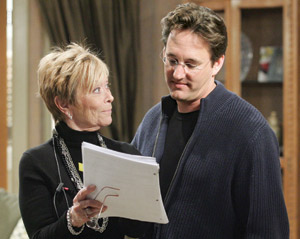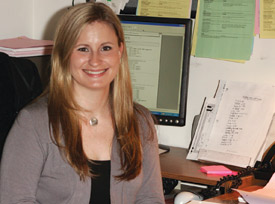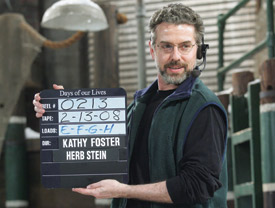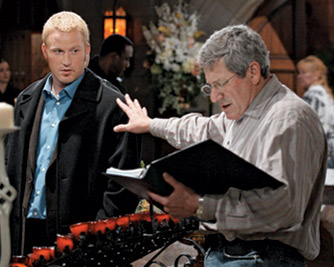BY JEANNE DORIN MCDOWELL



 STAGES OF LIFE: Stage manager Fran De Simone, working with cast, crew
STAGES OF LIFE: Stage manager Fran De Simone, working with cast, crew
and director Noel Maxam (opposite, right), is a master at multitasking.
When she started in 1975, she was the first woman on staff.
Francesca Bellini De Simone, known to all as "Fran," scrambles around the Days of our Lives set with the authority of a general, speed of a sprinter and competence of a den mother. Wearing a running suit and trademark sneakers, De Simone is a master at multitasking. She orchestrates the prompt arrival of actors on the set, ensures that everyone is where they should be and communicates with the director in the booth through a tiny remote ear bud that keeps her plugged in to all parts of the production. Having been a stage manager on Days of our Lives for 33 years—and the first woman at the network to hold that job—De Simone arguably knows more about the soap opera than any individual on the planet.
Although what she does hasn't changed all that much over the years, just about everything else on the set of the iconic soap opera has. Once a competitor in a bountiful universe of daytime melodramas, Days of our Lives now stands as NBC's sole surviving soap. (CBS recently pulled the plug on Guiding Light after 57 years.) The changing economics of television, a tighter bottom line, and a ratings slide have all conspired to endanger the genre in favor of more cheaply produced news, reality and talk shows. In November, two of the soap's biggest stars, Deidre Hall and Drake Hogestyn—who have nearly 50 years combined on Days—were cut from the cast as NBC reached a new deal with Sony Pictures TV to continue airing the show until 2010. Sony will still produce the soap, but the show's renewal came with a drastically reduced licensing fee, which meant less money to go around. In true soap style, the characters—wink, wink—were sent off to Europe. (NBC declined to comment on changes to the show.)
On a recent visit to the set of Days of our Lives, cozily ensconced at NBC's Burbank studio down the hall from The Tonight Show with Jay Leno, the fallout from the tectonic economic shifts is, at once, physically evident. Sets that once were sprawled over a large, cavernous area have been reconfigured within feet of each other to save space. The burgundy satin sheets of a bedroom scene are within arm's length of an office on one side and a formal living room on the other. A scene being shot at the Cheatin' Heart bar has only two female extras where not too long ago it would have been overflowing with action and people. "Everyone was here for an entire day," says De Simone. "Now they're staggered to come in only when needed."
But while Days of our Lives has fallen on hard times, it is a testament to the skills and professionalism of the people who turn out the beloved soap that, after 43 years, this well-oiled machine still manages to deliver one hour of TV five days a week to millions of fiercely loyal viewers—many of whom have been tuning in for decades. "There's a new unity among the entire ensemble," says Herb Stein, who's been a director on the show for nearly three decades and was nominated for a DGA Award in 2008. "It's a true collaboration in getting this number of pages done in the amount of time we have allotted. We know if we don't, the show will be off the air."
The biggest challenge comes in the form of an accelerated production schedule that demands cut-and-dry decisions and leaves very little time for creative flourishes. The directorial team and crew shoot seven episodes in five days. The actors memorize as many as 70 pages of dialogue on many nights and there is rarely a chance for a second take anymore. "We used to shoot a show that was around 65 pages. Yesterday I shot 140 pages, with two-thirds of the number of people that were there when we started," says Stein. Adds stage manager Stuart W. Howard, "There is no fat and no time to waste and there's hardly even time to joke. We clamp down and focus more then ever before. It's all business."
This is a far cry from production twenty, ten, even five years ago. When De Simone came aboard in 1975, the soap was filmed in one studio with six sets, two cameras and one boom. "It was two people sitting in a kitchen eating donuts and talking about their love lives," she jokes, noting that she was the first woman on staff and 'they all said I'd never last." In the '80s and '90s, the production expanded to three non-HD cameras, which are the ones used today, more booms and a large number of sets. That was the heyday of lavish production extravaganzas featuring outdoor filming, dozens of extras and complex story lines. The cast and crew shot a wedding scene in Santa Monica, a dream sequence of a southern ball, train and plane crashes and an island scene, among many others. In one plot twist, "Marlena [Hall] was even possessed by the devil and we flew her around the room and levitated her," De Simone recalls.


 FAST TRACK: Production associate Krista Cremidan, associate director
FAST TRACK: Production associate Krista Cremidan, associate director
Mike Fiamingo and stage manager Stuart W. Howard help keep
the show moving at a breakneck pace with limited resources.
Not too long ago the length of a workday was determined by when directors felt they had the best possible show in the can. That often meant 12 to 18-hour days that sometimes went in to the early morning. "We kept going until we got everything done," says De Simone. Today, the Days set typically closes down by 6 p.m. to avoid overtime. And story lines tend to revolve around relationships and emotional issues that call for simpler production.
That said, everyone on the directorial team, cast and crew, performs his or her job as efficiently as possible. Stage managers, who used to be the eyes and ears of the director on the floor, are more likely now to rush actors through scenes. Directors will sometimes shout instructions through a loudspeaker right onto the set to save time. "My biggest challenge is being able to let them go as fast as possible while still maintaining quality," says associate director Michael Fiamingo. "If the director wants to bypass something, I make sure he realizes what the result will be, making sure he stays on task and gets it done in as little time as possible." When Fiamingo started working seven years ago, there was only one director and his AD in the booth. Now, Days has gone back to the old system of one AD in the booth and one in the editing room. "We sit with the editors and look at cuts. By clarifying the notes, we make sure they stay true to the director's vision. We're all going so fast," says Fiamingo.
"Therein lies the rub," says supervising producer and director Noel Maxam, who directed Young and the Restless for 10 years before jumping to Days, where he was nominated for a DGA Award in 2008. "When you're working hard and have to make it as great as you can in only so much time and with only so much money, you have to stick your fork in and call it done."
Maxam says his job now also entails recognizing what each person on his team does well and letting him or her do it. The talents of each professional are valued more than ever before. "I play to people's strengths and take advantage of what people do really well." says Maxam. "Cameramen have to know exactly what to shoot. The boom guys have to be in the right place. The stage managers have to make the right call. The actors have to be able to memorize pages of dialogue and also give exemplary performances. But if any one of those things falls through the cracks, the whole system breaks down."
This means that scheduling is even more critical than usual. Upstairs in the office, production associate Krista Cremidan, who came to Days after several years on the now-defunct NBC soap Passions, works with the directors to create schedules and monitor call times. When a recent switched-at-birth story line called for a set of twins, Cremidan made sure to stagger their arrivals. Each infant was brought in separately so there would be no waste of the precious time they were permitted to be on set under federal labor laws.
This kind of planning ahead has become inherent in all aspects of Days of our Lives production, with very little left to chance. The directors plan each shot ahead of time, and flubbed lines and mistakes have to be fixed in the editing room. Maxam says he plans all exterior and interior shots so that they have the cameras where he needs them. "Every scene was dry blocked, camera blocked, dress rehearsed and then camera taped," says Stein. Tighter budgets also make remotes prohibitive and Stein tends to shoot fewer camera angles and shots, avoids remotes and has visually limited the amount of material he has to get through in a day.
 WELL-PREPARED: Director Noel Maxam works smart and relies on his close-knit team to get
WELL-PREPARED: Director Noel Maxam works smart and relies on his close-knit team to get
an almost impossible job done. "Still," he says, "I feel blessed to do this every day."
"I embrace simplicity," he says. "I'm more inclined to simplify blocking to insure quality and make sure there is less chance of error, while still telling the story so that it is compelling. That way, I'm going to feel less compromised as a director. But it's a constant fight as you can imagine; I always want to do a second take. Yesterday, of the 49 scenes shot, 90 percent were done on the first take."
Yet with all the constraints and new economic realities, there is no one on the set of Days of our Lives who doesn't want to deliver the best show possible. After all, there is a tradition to uphold. In the pantheon of daytime soaps, Days of our Lives is practically iconic. As Howard points out, the voice of MacDonald Carey—"Like sands through an hourglass, so are the Days of our Lives"—heard during the opening sequence for the past 41 years is woven into the history of daytime television. And Days is a bona fide cultural touchstone. When Joey (Matt LeBlanc) got a job in soaps on the sitcom Friends, it was on Days of our Lives.
Even now, a director or executive producer will occasionally make the very uncorporate-like decision to shoot a second take of a scene simply because the actor is almost there and wants the chance to make it better. "You need to deliver a good enough product for the audience to look at. You can't just throw it all out—the explosions, arty scenes, songs, montages. But now we have to be better and more efficient. That's the way it is, we work as smart as we can," says Maxam. "Still, I feel blessed to do this every day."
 PAGE TURNER: A tighter budget has made Herb Stein simplify how he
PAGE TURNER: A tighter budget has made Herb Stein simplify how he
directs. Now "it's a true collaboration in getting this number of pages
done in the amount of time we have."
And at the end of the day—shortened though it may be—there is still the sense of a job well done. "The idea that I am able to direct a scene and actually edit the entire scene from three or four different angles simultaneously is a rush," says Stein. "You're in the middle of the action while it's happening. It's most exciting when it starts to happen spontaneously and you get to go with it. It's like being on the top of ski slope: You're headed down the mountain to the end of the slope and you better have your shit together because you want that phenomenal take."
And while De Simone has witnessed huge changes in Days of our Lives since she signed on when it was flying high, she is proud that, despite the tighter budget and compressed schedule, "we're still getting it done."